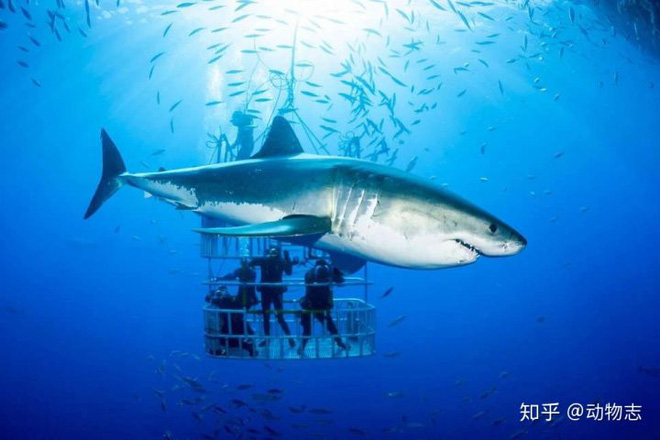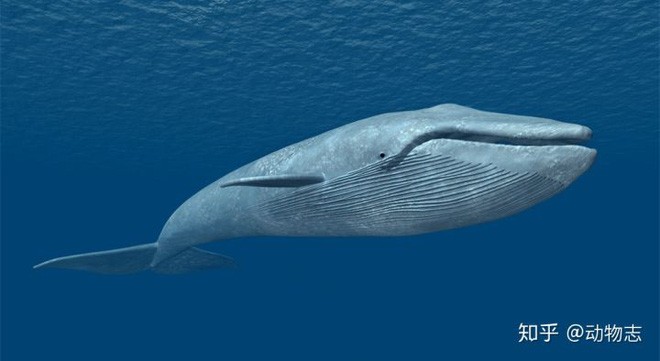Why do whales swing their tails up and down, but sharks swing their tails to the sides?
Whales, dolphins and sharks are rather large marine animals, when viewed from a distance, they seem quite similar, so how do you know if it is a ferocious white shark or A docile dolphin? To be able to distinguish this, most people rely on their swimming patterns and the shape of their caudal fins, if the tail is vertical, it's a shark, while the horizontal caudal fin is definitely a Dolphin. Similarly, when photographers take pictures from the air, they will distinguish it as a shark if their bodies swim continuously to the side and if waving from top to bottom, it is a dolphin or whale. So why are all marine creatures, they have a different way of swimming?

Although whales and dolphins now have their bodies evolved to suit aquatic life and look very much like other fish, they are essentially mammals, so their column structure is Their life is very different from that of fish.
Their spine mainly moves up and down, while the spine of the fish fluctuates to the sides. The bones in the tails of mammals are in fact the vertebrae of the tail, and are part of the vertebral column, so the direction of the tail's movements should be consistent with that of the entire spine. Therefore, mammals, including whales, mainly swing their tails up and down, while the fish wag their tails to the sides.

Why is there such a difference? Because terrestrial mammals, although whales are perfectly adapted to aquatic life now, their ancestors were terrestrial mammals. In order to adapt to terrestrial life, the first thing is to be able to move, so most land animals need to have legs. However, if the leg wants to move, it is necessary to have joints to connect the foot to the body and rotate in a certain direction in order to push the body forward.
Mammals have to move forward so their limbs need to move in a straight line. If the spine rotates to the sides, the movement of the spine and the movements of the limbs will not lie on the same plane, the whole body will be very hard, but if it is designed to be able to move upwards down then the limbs will be extremely flexible and can move through many different terrains. Therefore, mammals eventually chose to evolve so that their spine swayed up and down.

As for the fish, they have lived in the water for 500 million years since their appearance and have never lived on land. In the water, they do not need to have legs and bodies to easily swim in a way that moves the spine to the sides, so the spine of the fish does not need to change like mammals.
So when viewed from anatomical perspective, the spine of the fish is very hard when viewed from the side, while the column of mammals has a certain curvature and is much more flexible.

The skeletal structure of the fish.
In the mammalian skeletal structure, the ribs are connected bent to the sides to create compartments of the body and the vertebral spines are changed to open the rotation direction of the spine, supporting the body to develop in the direction of. Move up and down of the spine.
In addition, all mammals evolved from fish (fish → amphibians → reptiles → mammals), but about 50 million years ago, when the ancestors of the whales decided to return. back to the ocean when they left the water 250 million years. Their body structure is highly adapted to terrestrial life and cannot change the texture back to the shape of their ancestors as fish.
As a result, they had to adjust and alter the existing structure, the modified limbs to get a fin like shape, the tail degenerated to become thicker, healthier to be able to support the movement with aquatic life.

The skeletal structure of the whales.
Because of the difference in bone structure, fish move their spine to the sides and whales move up and down their tails. In addition, other marine mammals such as seals and sea lions all swim similarly to whales.

So which spine structure is more effective for survival? If on land, the advantages of up and down movement of the spine are obvious, because in this way, animals move faster and have better maneuverability.
Among the existing terrestrial vertebrates, crocodiles, lizards and snakes are the only species with the direction of the spine moving to the sides and they can only repel their belly to the ground. The vertebral column of higher animals, birds and mammals is mainly up and down.
The first four-legged species on Earth (Tetrapod) originated from fish and their spine initially fluctuated to the sides like crocodiles, but in order to adapt to terrestrial life, they had to change. Back structure of the spine.
In the more than 200 million years since the arrival of the dinosaurs, the animals that dominated the Earth were all vertebrates that moved up and down. Some argue that the advancement of dinosaurs in the way of movement is one of the advantages for them to become the animals that once dominated our planet for a long time.

However, in the water environment, there is no clear difference in the advantage between the movement of the spine up and down or oscillation to the sides.
Although fish have ruled the ocean for 500 million years and still flourish. Whales have only appeared in the ocean for several tens of millions of years, but they have evolved fully adapted to aquatic life and are ubiquitous, including species that grow into large creatures. largest on the planet.
In addition, the swimming ability of whales is not inferior to that of fish, so it can be shown that the spine movement in up and down direction or to both sides can adapt well to life. aquatic

You should read it
- The noise of ships affects the communication ability of marine creatures
- Why are marine creatures mostly predators and rarely see seagrass?
- Discover the longest giant marine species ever recorded
- Decipher the mystery of the extinction that destroyed 96% of marine life
- After completing the sea cable line SMW3, the Internet returned to normal
- The Vietnam Internet will go international on AAG submarine cable to be restored on 9/11
- The AAG fiber optic cable has just recovered, APG has a problem again
- The 'dead zone' on the ocean threatens the life and ecosystem of many seas
May be interested
- Video: Killer whale battle great gray whale, who is the sea king?
 a herd of killer whales attacked the mother of the gray whale. their target is the protein tongue of a baby gray whale.
a herd of killer whales attacked the mother of the gray whale. their target is the protein tongue of a baby gray whale. - Sharks plunge into gobbling up giant fish thousands
 the video captures a rare sight, sharks shattering and tearing the giant sardines of tens of thousands of fish off the hamptons beach, usa, astonishing many people.
the video captures a rare sight, sharks shattering and tearing the giant sardines of tens of thousands of fish off the hamptons beach, usa, astonishing many people. - Incredible facts about the animals
 here are unbelievable facts about animals that you may not have heard about such as the lizard's tongue is twice as long as their body, the otters often hold hands when sleeping, hippos' blood sweat. '...
here are unbelievable facts about animals that you may not have heard about such as the lizard's tongue is twice as long as their body, the otters often hold hands when sleeping, hippos' blood sweat. '... - New research suggests that the Sun may be the cause for gray whales to die from aground
 specifically, according to the new study, it is likely that solar storms have caused problems with the ability to navigate the whales, causing them to run aground.
specifically, according to the new study, it is likely that solar storms have caused problems with the ability to navigate the whales, causing them to run aground. - Why do hundreds of whales and dolphins 'collective suicide'?
 in recent studies, scientists believe they have found the reason for the large-scale suicide of whales and dolphins.
in recent studies, scientists believe they have found the reason for the large-scale suicide of whales and dolphins. - Detecting dead bodies of humpback whales on the coast of Sea Isle City, USA
 discovered the corpse of the humpback whale floating on the coast of sea isle city at 3 pm on friday, september 16.
discovered the corpse of the humpback whale floating on the coast of sea isle city at 3 pm on friday, september 16. - Close up of the screen to eat the scary prey of the 'ocean killer'
 sharks are known as ocean assassins with many layers of teeth lining the strong jaws, they often feed their prey vigorously when caught.
sharks are known as ocean assassins with many layers of teeth lining the strong jaws, they often feed their prey vigorously when caught. - eQuiz - Multiple choice test on Java Swing Practice - Part 2
 in the previous article, we introduced you to part 1 of the test of basic java swing knowledge. and below is part 2 of the quiz series with 14 questions, including some questions with many different answer options.
in the previous article, we introduced you to part 1 of the test of basic java swing knowledge. and below is part 2 of the quiz series with 14 questions, including some questions with many different answer options. - Assassin sharks ripped huge squid in death
 the last moments of the death battle between giant ink nearly 5m long and killer shark was witnessed by a diver and recorded.
the last moments of the death battle between giant ink nearly 5m long and killer shark was witnessed by a diver and recorded. - Scary aquatic monsters specialize in 'drilling' shark meat from within
 an eel-shaped fish has existed on earth for more than 300 million years before dinosaurs had strange feeding habits that terrified sharks and whales.
an eel-shaped fish has existed on earth for more than 300 million years before dinosaurs had strange feeding habits that terrified sharks and whales.










 New research shows Tyrannosaurus Tyrannosaurus relies on her sixth sense to 'love'?
New research shows Tyrannosaurus Tyrannosaurus relies on her sixth sense to 'love'? The mysterious bubble that appears in the center of the Milky Way galaxy is finally 'decoded'.
The mysterious bubble that appears in the center of the Milky Way galaxy is finally 'decoded'. 12 mysterious deepest holes in the planet
12 mysterious deepest holes in the planet Meteors have the power to destroy 10 billion atomic bombs hitting the Earth at the 'super dangerous' angle, completely eliminating dinosaurs
Meteors have the power to destroy 10 billion atomic bombs hitting the Earth at the 'super dangerous' angle, completely eliminating dinosaurs Misconceptions about biology that many people still believe in.
Misconceptions about biology that many people still believe in. The inventions show the sublime intelligence of Leonardo da Vinci
The inventions show the sublime intelligence of Leonardo da Vinci